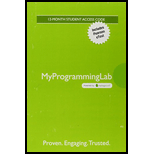
MyLab Programming with Pearson eText -- Access Card -- for Introduction to Java Programming and Data Structures, Comprehensive Version
11th Edition
ISBN: 9780134672816
Author: Liang
Publisher: PEARSON
expand_more
expand_more
format_list_bulleted
Concept explainers
Question
Chapter 28, Problem 28.17PE
Program Plan Intro
Program Plan:
- Include the required import statement.
- Create a package “main”.
- Add a java class named “Edge” to the package which is used to get the edges from the graph.
- Add a java class named “Graph” to the package which is used to add and remove vertices, edges.
- Add a java class named “UnweightedGraph” to the package which is used to store vertices and neighbors.
- Add a java class named “WeightedGraph” to the package which is used to get the weighted edges and print the edges.
- Add a java class named “WeightedEdge” to the package which is used to compare edges.
- Add a java class named “NineTailModel” to the package which is used to compare edges.
- Define the main method using public static main.
- Allocate memory to the class “Test”.
- Define the “Test” class.
- Declare and set the values for the variables.
- Create an object1 for the “Graph” class.
- Display the edge.
- Allocate memory for the “edge” variable.
- Create an object2 for the “Graph” class.
- Display the edge.
- Display the results.
- Define the “Graph” class.
- A graph interface gets created.
- Method to return the size gets defined.
- Method to return the vertices gets defined.
- Method to return the index gets created.
- Method to get the neighbor node gets created.
- Method to get the degree gets created.
- Method to print the edges.
- Method to clear the node gets created.
- Method to add the edges, add vertex gets created.
- Method to remove the vertices gets defined.
- Method for the depth first search gets defined.
- Method for the breadth first search gets defined.
- Create a class “UnweightedGraph”:
- New list for the vertices gets created.
- New list for the neighbor node gets created.
- Create an empty constructor.
- Method to create new graph gets created and adjacency list gets created.
- Method to create an adjacency list gets created.
- Method to return the size of the vertices.
- Method to return the index of the vertices gets defined.
- Method to gets the neighbor node gets defined.
- Method to return the degree of the vertices gets created.
- Method to print the Edges gets created.
- New to clear the graph gets created.
- Method to add vertex gets created.
- Method to add edge gets created.
- Method to perform the depth first search gets defined.
- Method to perform breadth first search gets defined.
- Search tree gets returned.
- Create a class “SearchTree”
- Define the method to return the root.
- Method to return the parent of the vertices
- Method to return the search order gets defined.
- Method to return the number of vertices found gets defined.
- Method to get the path of the vertices gets defined.
- Loop to validate the path gets defined.
- Path gets returned.
- Method to print the path gets defined.
- Method to print the tree gets defined.
- Display the edge.
- Display the root.
- Condition to validate the parent node to display the vertices gets created.
- Define the “getHamiltonianPath” method.
- If the size of graph is equal to “i” value, return a Hamiltonian path from the specified vertex object.
- Otherwise, return null if the graph does not have a Hamiltonian path.
- Define the “getHamiltonianPath” method.
- Return the value using array list.
- Define the “getHamiltonianPath” method.
- Declare the required variables.
- If the length of the graph, indicate no subpath from “i” is found.
- The vertices in the Hamiltonian path are stored in result.
- Reorder the adjacency list for each vertex.
- Create a list for path
- Add vertex to the result list.
- Get the next vertex in the path.
- Return null if no Hamiltonian path is found.
- Define the “reorderNeigborsBasedOnDegree” method.
- Check the condition.
- Find the maximum in the list.
- Check the condition and swap the list with another list.
- Check the condition.
- Define the “allVisited” method.
- Declare the variables.
- Check if all the elements in array is visited and return true.
- Otherwise return the result.
- Define the “getHamiltonianPath” method.
- Declare the variables
- If all the vertices are found then include all the vertices.
- Then search for a Hamiltonian path from “v”.
- Define “getHamiltonianCycle” method.
- Return a Hamiltonian cycle.
- Define “getHamiltonianCycle” method.
- Declare the variable.
- If the length of the graph, indicate no subpath from “i” is found.
- The vertices in the Hamiltonian path are stored in result.
- Reorder the adjacency list for each vertex.
- Create a list for path
- Add vertex to the result list.
- Get the next vertex in the path.
- Return null if no Hamiltonian path is found.
- Define “getHamiltonianCycle” method.
- Declare the variable.
- If all the vertex is visited the return true.
- Otherwise backtrack “v” is marked unvisited.
- Return false.
- Define “isCycle” method.
- Return the value.
Expert Solution & Answer
Want to see the full answer?
Check out a sample textbook solution
Students have asked these similar questions
Write the SQL code that permits to implement the tables: Student and Transcript. NB: Add the constraints on the attributes – keys and other.
Draw an ERD that will involve the entity types: Professor, Student, Department and Course. Be sure to add relationship types, key attributes, attributes and multiplicity on the ERD.
Draw an ERD that represents a book in a library system. Be sure to add relationship types, key attributes, attributes and multiplicity on the ERD.
Chapter 28 Solutions
MyLab Programming with Pearson eText -- Access Card -- for Introduction to Java Programming and Data Structures, Comprehensive Version
Ch. 28.2 - What is the famous Seven Bridges of Knigsberg...Ch. 28.2 - Prob. 28.2.2CPCh. 28.2 - Prob. 28.2.3CPCh. 28.2 - Prob. 28.2.4CPCh. 28.3 - Prob. 28.3.1CPCh. 28.3 - Prob. 28.3.2CPCh. 28.4 - Prob. 28.4.1CPCh. 28.4 - Prob. 28.4.2CPCh. 28.4 - Show the output of the following code: public...Ch. 28.4 - Prob. 28.4.4CP
Ch. 28.5 - Prob. 28.5.2CPCh. 28.6 - Prob. 28.6.1CPCh. 28.6 - Prob. 28.6.2CPCh. 28.7 - Prob. 28.7.1CPCh. 28.7 - Prob. 28.7.2CPCh. 28.7 - Prob. 28.7.3CPCh. 28.7 - Prob. 28.7.4CPCh. 28.7 - Prob. 28.7.5CPCh. 28.8 - Prob. 28.8.1CPCh. 28.8 - When you click the mouse inside a circle, does the...Ch. 28.8 - Prob. 28.8.3CPCh. 28.9 - Prob. 28.9.1CPCh. 28.9 - Prob. 28.9.2CPCh. 28.9 - Prob. 28.9.3CPCh. 28.9 - Prob. 28.9.4CPCh. 28.10 - Prob. 28.10.1CPCh. 28.10 - Prob. 28.10.2CPCh. 28.10 - Prob. 28.10.3CPCh. 28.10 - If lines 26 and 27 are swapped in Listing 28.13,...Ch. 28 - Prob. 28.1PECh. 28 - (Create a file for a graph) Modify Listing 28.2,...Ch. 28 - Prob. 28.3PECh. 28 - Prob. 28.4PECh. 28 - (Detect cycles) Define a new class named...Ch. 28 - Prob. 28.7PECh. 28 - Prob. 28.8PECh. 28 - Prob. 28.9PECh. 28 - Prob. 28.10PECh. 28 - (Revise Listing 28.14, NineTail.java) The program...Ch. 28 - (Variation of the nine tails problem) In the nine...Ch. 28 - (4 4 16 tails problem) Listing 28.14,...Ch. 28 - (4 4 16 tails analysis) The nine tails problem in...Ch. 28 - (4 4 16 tails GUI) Rewrite Programming Exercise...Ch. 28 - Prob. 28.16PECh. 28 - Prob. 28.17PECh. 28 - Prob. 28.19PECh. 28 - (Display a graph) Write a program that reads a...Ch. 28 - Prob. 28.21PECh. 28 - Prob. 28.22PECh. 28 - (Connected rectangles) Listing 28.10,...Ch. 28 - Prob. 28.24PECh. 28 - (Implement remove(V v)) Modify Listing 28.4,...Ch. 28 - (Implement remove(int u, int v)) Modify Listing...
Knowledge Booster
Learn more about
Need a deep-dive on the concept behind this application? Look no further. Learn more about this topic, computer-science and related others by exploring similar questions and additional content below.Similar questions
- 2:21 m Ο 21% AlmaNet WE ARE HIRING Experienced Freshers Salesforce Platform Developer APPLY NOW SEND YOUR CV: Email: hr.almanet@gmail.com Contact: +91 6264643660 Visit: www.almanet.in Locations: India, USA, UK, Vietnam (Remote & Hybrid Options Available)arrow_forwardProvide a detailed explanation of the architecture on the diagramarrow_forwardhello please explain the architecture in the diagram below. thanks youarrow_forward
- Complete the JavaScript function addPixels () to calculate the sum of pixelAmount and the given element's cssProperty value, and return the new "px" value. Ex: If helloElem's width is 150px, then calling addPixels (hello Elem, "width", 50) should return 150px + 50px = "200px". SHOW EXPECTED HTML JavaScript 1 function addPixels (element, cssProperty, pixelAmount) { 2 3 /* Your solution goes here *1 4 } 5 6 const helloElem = document.querySelector("# helloMessage"); 7 const newVal = addPixels (helloElem, "width", 50); 8 helloElem.style.setProperty("width", newVal); [arrow_forwardSolve in MATLABarrow_forwardHello please look at the attached picture. I need an detailed explanation of the architecturearrow_forward
- Information Security Risk and Vulnerability Assessment 1- Which TCP/IP protocol is used to convert the IP address to the Mac address? Explain 2-What popular switch feature allows you to create communication boundaries between systems connected to the switch3- what types of vulnerability directly related to the programmer of the software?4- Who ensures the entity implements appropriate security controls to protect an asset? Please do not use AI and add refrencearrow_forwardFind the voltage V0 across the 4K resistor using the mesh method or nodal analysis. Note: I have already simulated it and the value it should give is -1.714Varrow_forwardResolver por superposicionarrow_forward
- Describe three (3) Multiplexing techniques common for fiber optic linksarrow_forwardCould you help me to know features of the following concepts: - commercial CA - memory integrity - WMI filterarrow_forwardBriefly describe the issues involved in using ATM technology in Local Area Networksarrow_forward
arrow_back_ios
SEE MORE QUESTIONS
arrow_forward_ios
Recommended textbooks for you
 C++ Programming: From Problem Analysis to Program...Computer ScienceISBN:9781337102087Author:D. S. MalikPublisher:Cengage Learning
C++ Programming: From Problem Analysis to Program...Computer ScienceISBN:9781337102087Author:D. S. MalikPublisher:Cengage Learning LINUX+ AND LPIC-1 GDE.TO LINUX CERTIF.Computer ScienceISBN:9781337569798Author:ECKERTPublisher:CENGAGE L
LINUX+ AND LPIC-1 GDE.TO LINUX CERTIF.Computer ScienceISBN:9781337569798Author:ECKERTPublisher:CENGAGE L EBK JAVA PROGRAMMINGComputer ScienceISBN:9781337671385Author:FARRELLPublisher:CENGAGE LEARNING - CONSIGNMENT
EBK JAVA PROGRAMMINGComputer ScienceISBN:9781337671385Author:FARRELLPublisher:CENGAGE LEARNING - CONSIGNMENT New Perspectives on HTML5, CSS3, and JavaScriptComputer ScienceISBN:9781305503922Author:Patrick M. CareyPublisher:Cengage Learning
New Perspectives on HTML5, CSS3, and JavaScriptComputer ScienceISBN:9781305503922Author:Patrick M. CareyPublisher:Cengage Learning C++ for Engineers and ScientistsComputer ScienceISBN:9781133187844Author:Bronson, Gary J.Publisher:Course Technology Ptr
C++ for Engineers and ScientistsComputer ScienceISBN:9781133187844Author:Bronson, Gary J.Publisher:Course Technology Ptr

C++ Programming: From Problem Analysis to Program...
Computer Science
ISBN:9781337102087
Author:D. S. Malik
Publisher:Cengage Learning

LINUX+ AND LPIC-1 GDE.TO LINUX CERTIF.
Computer Science
ISBN:9781337569798
Author:ECKERT
Publisher:CENGAGE L

EBK JAVA PROGRAMMING
Computer Science
ISBN:9781337671385
Author:FARRELL
Publisher:CENGAGE LEARNING - CONSIGNMENT

New Perspectives on HTML5, CSS3, and JavaScript
Computer Science
ISBN:9781305503922
Author:Patrick M. Carey
Publisher:Cengage Learning

C++ for Engineers and Scientists
Computer Science
ISBN:9781133187844
Author:Bronson, Gary J.
Publisher:Course Technology Ptr
